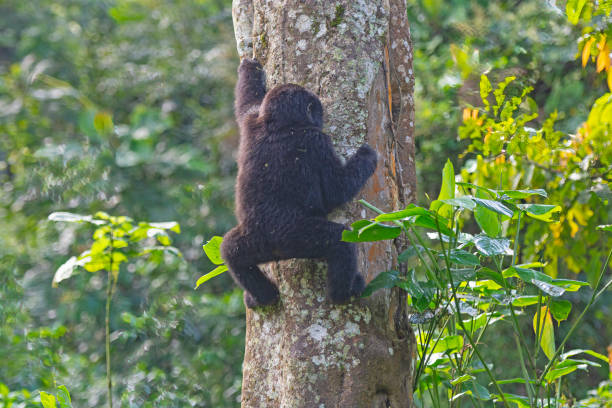
With about over 1000 gorillas in the world, more than half of these magnificent creatures are situated in the Bwindi Impenetrable Conservation Area and the smaller number in the Central part of Africa. Classified as the Western Lowland Gorillas (Gorilla Gorilla) and Eastern Gorillas (Gorilla Beringei) and each has 2 sub species. Gorillas have been listed and considered Endangered by the IUCN. Mountain Gorillas are located in both East and Central Africa with the bigger group In Bwindi Impenetrable Forest and Mgahinga Gorilla National Park in Uganda and the smaller group in the Virunga Volcanoes; bordering Uganda, Rwanda and Democratic Republic of Congo.
Mountain Gorillas also known as Gorilla Beringei being our main focus are the kind found in Uganda and take up more than half the world population. Their name hints at their habitat as they live in the mountains at an elevation of 8,000-13,000ft with thick fur which comes in handy as it helps them survive by keeping them warm as the temperatures are often below freezing. Males will be bigger than the females with silver hair on their backs and large bumps on their heads called Sagittal Crests. This information however helps little in regards to the young males and females. Mountain gorillas live in families and share 98% of the human DNA with a weakness of slow speed and poor sight which means they can only run for short distances.
The average lifespan of mountain gorillas is 35-40 years however it goes up to 50 years for those who are situated in zoos and we have Fatou as the oldest gorilla found in a zoo in Berlin, Germany. With arthritis which damages their bones and loss of teeth which can interfere with feeding, in general the gorillas have a full life as per their lifespan. Gorillas are considered mature at the age of 8 however the females are ready for conceiving at the age of 10. Gorillas are very strong and can carry things ten times bigger than them and are four times stronger than a man due to the immense muscle strength, however they are scared of chameleons, caterpillars and water. When it comes to water, even if they must cross they try their hardest to expose very little of their bodies to water.
The gestation period of a female gorilla is 8 and a half months, however once she is pregnant it is hard to know that she is, as they naturally have big stomachs for digestions but some females have swollen knuckles when pregnant. At 10 years is when a female gorilla can conceive and once they give birth, they will take between 4-6years before they can conceive again unfortunately 26% of the babies don’t make it past the first year with first time mothers having a higher infant mortality rate.
Females reach maturity sexually between 10-12years though their ovulation cycle arrives earlier at 6years however they remain infertile until they turn 10years old while males mature later at the age of 15-20yrs and are rarely strong or dominant enough to reproduce until then. Females are estrus for 1-2days monthly and it’s during this time that the dominant silverback will have breeding or mating rights. Like humans, mountain gorillas reproduce slowly as they take about 4years of caring for their young which makes them endangered in regards to population declines. The females always birth singles though on rare occasions twins come around.
Male gorillas who are adults normally assume the leadership role as the dominant silverback, keep the group cohesive and also have the best access to the females for mating; and with the help of other male gorillas they also provide protection for the family and mediate conflict. Females ensure the social structure and reproduction of the group, take care of the new additions of the group. Males normally separate from their original families at the age of 11, they will either go alone or go with other males and form another group until they are old enough to attract females of their own to increase the new formed group/family.
When tracking gorillas one must have certain essentials to ease the process and ensure an enjoyable experience as rules are designed to protect the primates and the requirements to ensure the process is smooth. Before tracking, one must be 15years and above and must also have a tracking permit giving them access to these beautiful apes. The tourists must also have hiking boots, cotton thick socks, waterproof rain jackets, appropriate clothing, gloves, snacks, drinking water, medical kit, insect repellant, cameras, walking sticks and others depending on how fit one it and how much they can carry on them. One must approach gorilla tracking with a respectful attitude towards the gorillas and their habitat. Follow the instructions of your guides, maintain a safe distance from the gorillas, and avoid making loud noises or sudden movements that could disturb them.
Trekking permits are documents issued by Uganda Wildlife Authority to all visitors 15years and above allowing them to visit the gorilla habituated families. Gorilla trekking is done in Bwindi Impenetrable Forest and Mgahinga Gorilla National Park which two parks harbor more than half of the world’s mountain gorilla population. The prices of trekking are determined by a tourist’s nationality as residents and foreigners are costed differently.
Gorilla trekking for East African citizens is 250,000UGX per person, 700$ per person for foreign residents and 800$ per person for foreign non-residents while those who would prefer spending more time with the magnificent gorillas will pay 750,000UGX for East African citizens, 1,000$ for foreign residents and 1,500$ for foreign non-residents per person. This money is to be paid at Uganda Wildlife Authority directly or through a trusted operator like Glory Summit Tours and Travels. Once the availability of the dates desired by the tourists are confirmed, a deposit is made to secure the slot desired and this has to be done at least 3months prior to the desired dates. The permit covers entrance to the park, trekking, experienced guides and rangers to ensure safety for both you and the primates.
